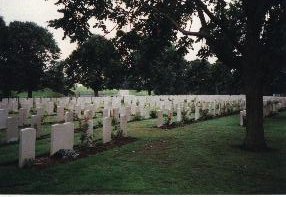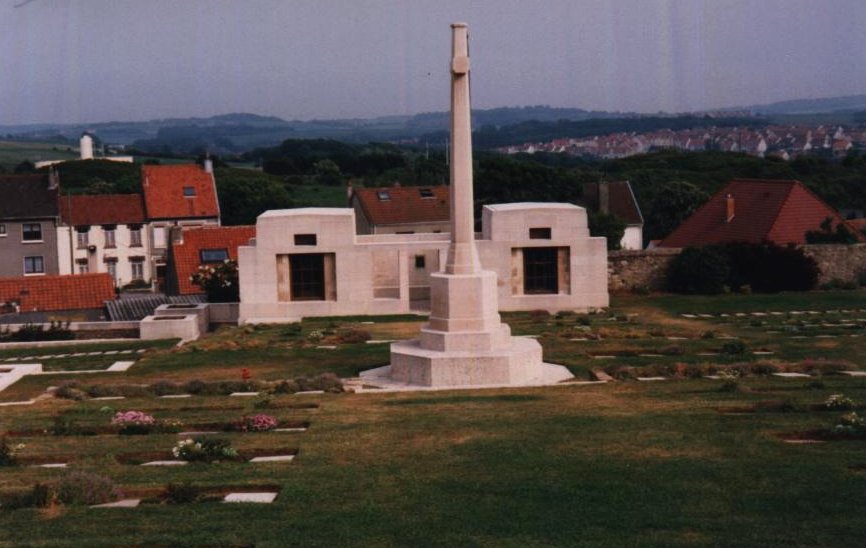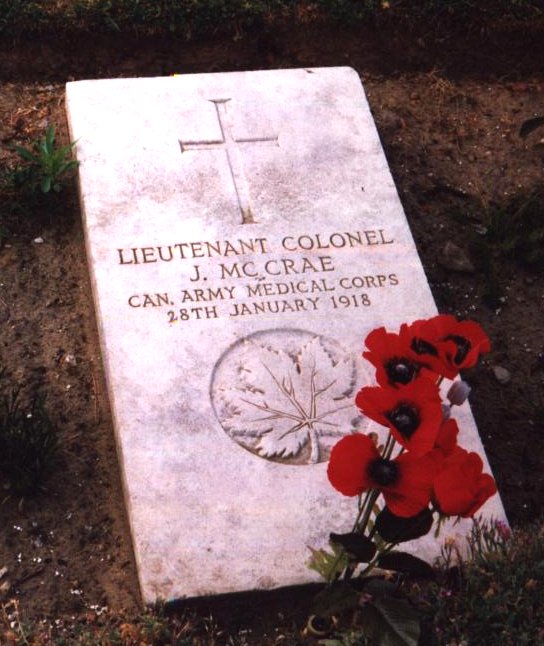(CWGC Ref 5/28)

The front lines between here and Ypres ran roughly parallel to, and beyond, the canal and at slightly varying distances according to how the battles were going, but here at the canal bank lived a unique community of men those function was to support those in the line.
Canadian Medical officer Colonel John McCrae, who had served with the Artillery in the Boer War, had written what is perhaps the war's best-known poem.
"In Flanders Fields"
"In Flanders fields the poppies blow
Between the crosses, row on row,
That mark our place; and in the sky
The larks, still bravely singing fly
Scarce heard amid the guns below.
We are the dead. Short days ago
We lived, felt dawn, saw sunset glow,
Loved and were loved, and now we lie,
In Flanders fields.
Take up our quarrel with the foe:
To you from failing hands we throw
The torch; be yours to hold it high.
If ye break faith with those who die
We shall not sleep, though poppies grow
In Flanders fields."
John McCrae
The poem was first published in PUNCH on 8th December 1915, and become an instant popular success, from it was taken the symbol of the poppy for the British Legion to respect remembrance of those who gave their lives in the Great War and subsequent conflicts.

On 24th April McCrae wrote home with a moving account of the Second Battle of Ypres. He saw the 'asphyxiated French soldiers', ' the very picture of debacle'. Afterwards, he wrote, 'For 36 hours we had no infantryman between us and the Germans and this gap was 1,200 to 1,500 yards wide. God knows why the Germans did not put in a big force to eat us up. We really expected to die.' By the 25th April the Canadians had lost an estimated 6,000 of their 10,000 strength. On 2nd May, on of McCrae's patients and a friend, Lt. A Helmer, was virtually blown to pieces by a direct shell. McCrae was touched by Helmer's last diary entry, which read, ' It has quieted a little and I shall try to get a good sleep'.
Another account of the area comes from Harry Kendall (1st King Edward's Horse - Third Ypres).
"I ... stationed for some time on these crossroads nr#ear the Essex Farm graveyard. Fritz had a bad habit of sending shells over and ploughing up the graves. For many weeks there was little peace at that end of Essex Farm road - even for the 'glorious' dead. Often a dozen a day ere smothered over with mud from the graves torn by Fritz's exhuming shells ... Possibly the worst phase of this post by number four bridge was the eternal review of dead men before one's tiring eyes. Slaughtered men lying about in all shapes and forms around this unholy post of ours."

Essex Farm Cemetery
Buried in this cemetery is one of the youngest known casualties of the war, Private Joe Strudwick of the Rifle Brigade, aged just 15 (the youngest known is that of Private John Condon of the 2nd Royal Irish Regiment, who died 24th May 1915, aged just 14 and is buried in Poelkapelle British Cemetery). Below is Commemorative Information from the CWGC site for Private Joe Strudwick, it also gives good information on the area and cemetery itself.
| Citation: | Valentine Strudwick was among the very
young who died on service, being only fifteen years old at the time of
his death. |
| Additional Information: | Son of Louisa Strudwick, of 70, Orchard Rd., Dorking. |
| Cemetery: | ESSEX FARM CEMETERY, BOEZINGE, Ieper, West-Vlaanderen, Belgium |
| Grave Reference/ Panel Number: |
I. U. 8. |
| Location: | Boezinge is a village in the province of
West Flanders, north of Ieper on the Diksmuidseweg road (N369). From the
station turn left into M.Fochlaan and go to the roundabout. Then turn
right and continue to the next roundabout. Turn left and drive to the
next roundabout and then turn right into Oude Veurnestraat. Take the 2nd
turning on the left, which is the Diksmuidseweg, and follow the road
under the motorway bridge; the Cemetery will be found on the right hand
side of the road. |
| Historical Information: | Boesinghe (Boezinge) village during the greater part of the War, directly faced by the German front line on the East side; but further South the British line was several kilometres East of the canal. A little less than mid-way from Ypres to Boezinge there was a farm building, in the narrow space between the road and the canal bank, known by the Army as Essex Farm. The land South of the farm came into use as a Dressing Station cemetery in April, 1915, and it remained in use until August, 1917. The burials were made without definite plan, and some of the Divisions which occupied this sector may be traced in almost every part of the cemetery; but the 49th (West Riding) Division buried their dead of 1915 in Plot I, and the 38th (Welsh) Division in the autumn of 1916 used Plot III. There are now over 1,000, 1914-18 war casualties commemorated in this site. Of these, over 100 are unidentified and special memorials are erected to 19 soldiers from the United Kingdom, known or believed to be buried among them. The cemetery covers an area of 6,032 square metres and is enclosed by a low rubble wall on the South side and part of the East. The 49th Division Memorial is immediately behind the cemetery, on the canal bank. |
John McCrae was later promoted and by 1918 was a Lt. Colonel at abase hospital near Boulogne. Having worm himself out, he died of pneumonia in January that year and was buried in Wimereux Cemetery.

